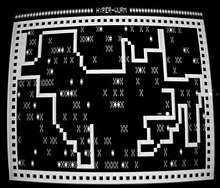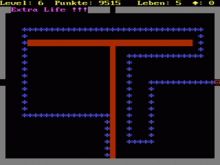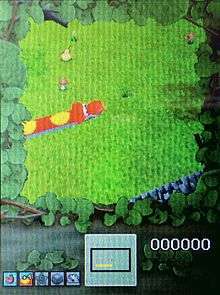Snake (video game genre)


Snake is the common name for a video game concept where the player maneuvers a line which grows in length, with the line itself being a primary obstacle. The concept originated in the 1976 arcade game Blockade, and the ease of implementing Snake has led to hundreds of versions (some of which have the word snake or worm in the title) for many platforms. After a variant was preloaded on Nokia mobile phones in 1998, there was a resurgence of interest in the snake concept as it found a larger audience. There are over 300 Snake-like games for iOS alone.[2]
Gameplay
The player controls a dot, square, or object on a bordered plane. As it moves forward, it leaves a trail behind, resembling a moving snake. In some games, the end of the trail is in a fixed position, so the snake continually gets longer as it moves. In another common scheme, the snake has a specific length, so there is a moving tail a fixed number of units away from the head. The player loses when the snake runs into the screen border, a trail or other obstacle, or itself.
The Snake concept comes in two major variants:
- In the first, which is most often a two-player game, there are multiple snakes on the playfield. Each player attempts to block the other so he or she runs into an existing trail and loses. Surround for the Atari 2600 is an example of this type. The Light Cycles segment of the Tron arcade game is a single-player version where the other "snakes" are AI controlled.
- In the second variant, a sole player attempts to eat items by running into them with the head of the snake. Each item eaten makes the snake longer, so controlling is progressively more difficult. Examples: Nibbler, Snake Byte.
History
The Snake design dates back to the arcade game Blockade,[3][4] developed and published by Gremlin in 1976.[5] It was cloned as Bigfoot Bonkers the same year. In 1977, Atari released two Blockade-inspired titles: the arcade game Dominos and Atari VCS game Surround.[6] Surround was one of the nine Atari VCS (later the Atari 2600) launch titles in the United States and was also sold by Sears under the name Chase. That same year, a similar game was launched for the Bally Astrocade as Checkmate.[7]
The first known personal computer version, titled Worm, was programmed in 1978 by Peter Trefonas of the US on the TRS-80,[3] and published by CLOAD magazine in the same year. This was followed shortly afterwards with versions from the same author for the Commodore PET and Apple II. A microcomputer clone of the Hustle arcade game, itself a clone of Blockade, was written by Peter Trefonas in 1979 and published by CLOAD.[8] An authorized version of Hustle was published by Milton Bradley for the TI-99/4A in 1980.[9] In 1982's Snake for the BBC Micro, by Dave Bresnen, the snake is controlled using the left and right arrow keys relative to the direction it is heading in. The snake increases in speed as it gets longer, and there's only one life; one mistake means starting from the beginning.
Nibbler (1982) is a single-player arcade game where the snake fits tightly into a maze, and the gameplay is faster than most snake designs. Another single-player version is part of the 1982 Tron arcade game, themed with light cycles. It reinvigorated the snake concept, and many subsequent games borrowed the light cycle theme.
Starting in 1991, Nibbles was included with MS-DOS for a period of time as a QBasic sample program. In 1992 Rattler Race was released as part of the second Microsoft Entertainment Pack. It adds enemy snakes to the familiar apple-eating gameplay.
Slither.io (2016) is a massively multiplayer version of Snake.
In 2017, Google released their version of the game as an easter egg, whenever the phrases "snake","play snake", "snake game" and "snake video game" are typed.[10]
Nokia phones

Nokia is known for putting Snake on the majority of their phones. Versions include:
- Snake – The first published by Nokia, for monochrome phones. Graphics consisted of black squares, and it had 4 directions. It was programmed in 1997 by Taneli Armanto, a design engineer in Nokia[11] and introduced on the Nokia 6110.[12]
- Snake II – Included on monochrome phones. Snake improved to a snake pattern, introduction of bonus bugs, a 'Circumnavigate play area' and mazes (obstacle walls placed within the play area). An example of a phone with it installed is the Nokia 3310 from 2000.
- Snake Xenzia – Included on later-model monochrome phones (and some cheaper colour phones, such as the Nokia 1600). An example of a phone with it installed is the Nokia 1112 from 2006.
- Snake EX – Included on colour phones. First introduced with the Nokia 9290 Communicator in 2002. Graphics improved to SNES quality. It supports multiplayer through Bluetooth and Infra-Red. An example of a phone with it installed is the Nokia 6260 from 2004.
- Snake EX2 – Introduced with the Nokia 3100 in 2003. This is included in several Series 40 handsets by Nokia but is not available in Series 40 handsets with a 240×320 display resolution (instead it comes with Snake III).
- Snakes – A 3D version. This game was designed for the N-Gage in 2005, developed by IOMO (published by Nokia). It featured multiplayer through Bluetooth. Graphics improved to basic PlayStation quality. Introduction of hex levels, etc. Later Nokia started giving this game pre-installed (without multiplayer feature) in some Nseries smartphones like N70, N73, N80, etc. Snakes can be downloaded from the Nokia support page's Games section and played on any S60 device.[13]
- Snake III – A 3D version, different from Snakes. Snake III takes a more living snake approach, rather than the abstract feel of Snakes. An example of a phone with it installed is the Nokia 3250 from 2005. It is also available on the Nokia 5310, Nokia 5610, Nokia 2700 classic,[14] Nokia 2730 classic, Nokia X2-00 and the Nokia 6300, and it supports multiplayer modes via Bluetooth.
- Snakes Subsonic - Sequel to Snakes, released on May 22, 2008 on the N-Gage platform.
- Snake (2017) - Released with the Nokia 3310 (2017) and Nokia 8110 (2018)
- Snake (2017) - Released with Facebook Messenger (2017)
On November 29, 2012, the Museum of Modern Art in New York City announced that the Nokia port of Snake was one of 40 games that the curators wished to add to the museum's collection in the future.[15]
The Nokia Snake game was acquired by Gameloft in 2017, for use on the newer Nokia-branded feature phones such as the 2017 Nokia 3310.[16]
Reception
In 1996 Next Generation ranked it number 41 on their "Top 100 Games of All Time", citing the need for both quick reactions and forethought. Due to the game's numerous incarnations, in lieu of a title they listed it as "Snake game" in quotes.[17]
References
- ↑ Tieturi 2/1985 ISSN 0780-9778
- ↑ "Other Snake Games". Archived from the original on August 18, 2016. Retrieved July 5, 2016.
- 1 2 Gerard Goggin (2010), Global Mobile Media, Taylor & Francis, p. 101, ISBN 0-415-46917-1, retrieved April 7, 2011
- ↑ Rusel DeMaria & Johnny L. Wilson (2003). High score!: the illustrated history of electronic games (2 ed.). McGraw-Hill Professional. p. 24. ISBN 0-07-223172-6. Retrieved April 7, 2011.
- ↑ "Blockade video game, Gremlin Ind, inc. (1976)". Arcade-history.com. April 4, 2008. Archived from the original on June 11, 2011. Retrieved November 4, 2011.
- ↑ Blockade at the Killer List of Videogames
- ↑ Rusel DeMaria & Johnny L. Wilson (2003). High score!: the illustrated history of electronic games (2 ed.). McGraw-Hill Professional. p. 48. ISBN 0-07-223172-6.
- ↑ "You have 4537 of 4549 known Tandy Radio Shack TRS-80 - Model I games". Archived from the original on August 12, 2011. Retrieved November 4, 2011.
- ↑ "Retrogaming Times Monthly 7". My.stratos.net. January 1, 2005. Archived from the original on September 22, 2011. Retrieved November 4, 2011.
- ↑ Gesenhues, Amy (September 27, 2017). "Google's latest Easter Egg is a video game that shows up with searches for 'snake' & 'play snake'". Search Engine Land. Retrieved November 1, 2017.
- ↑ More, James (January 20, 2009). "History of Nokia part 2: Snake | Nokia Conversations - The official Nokia Blog". Conversations.nokia.com. Archived from the original on July 23, 2011. Retrieved November 4, 2011.
- ↑ "Taneli Armanto: Snake Creator Receives Special Recognition". Dexigner. Archived from the original on 2 October 2017. Retrieved 6 March 2013.
- ↑ neoncherry (August 12, 2007). "The Unofficial Nokia Gaming Blog: Snakes for S60 Download". Web.archive.org. Archived from the original on November 1, 2007. Retrieved November 4, 2011.
- ↑ "Archived copy". Archived from the original on March 21, 2015. Retrieved March 25, 2015.
- ↑ "Archived copy". Archived from the original on September 8, 2015. Retrieved March 24, 2016.
- ↑ Nokia 3310 relaunched today with new version of Snake, archived from the original on 28 June 2017, retrieved 14 June 2017
- ↑ "Top 100 Games of All Time". Next Generation. No. 21. Imagine Media. September 1996. pp. 55–56.
External links
| Wikimedia Commons has media related to Snake (video game). |